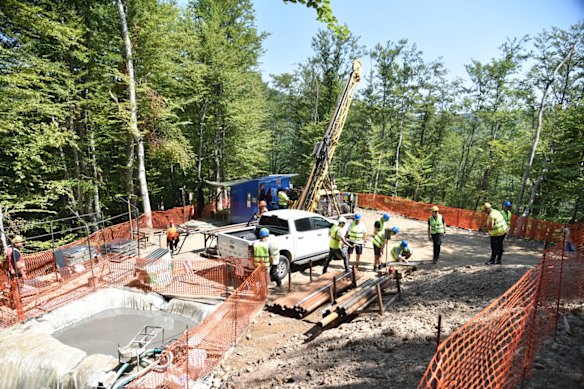- Sponsored
- Business
- Companies
- Bulls N' Bears
Strickland hits 97.9% gold recovery in Serbian met tests
Brought to you by BULLS N’ BEARS
By Doug Bright
Strickland Metals has achieved gold recoveries of up to 97.9 per cent and an average recovery of 89.9 per cent using standard flotation methods at its Gradina deposit, which is part of its 7.4-million-ounce gold equivalent Rogozna project in Serbia.
The exceptional metallurgical testwork results build on 2021 testwork that showed an 87.9 per cent gold recovery. Seven 250 kilogram bulk samples from the gold-dominant Gradina deposit were tested at ALS Metallurgy Laboratories in Perth.

One of Strickland Metals’ eight diamond drill rigs operating at the company’s Rogozna project in Serb
The latest samples, sourced from 2024 drill holes across the deposit, underwent flotation testing to confirm the proposed flowsheet.
Gold recoveries ranged from 64.3 per cent to 97.9 per cent, and averaged 89.9 per cent, with final concentrate grades between 6.7 grams per tonne (g/t) and 57.8g/t and averaging 26.1g/t. Silver recoveries averaged 62.9 per cent, with final concentrate grades between 4.4g/t and 90.3g/t. The calculated head grades averaged 3.8g/t gold and 5.1g/t silver.
The lowest gold recovery of 64.3 per cent came from a rare, partly-oxidised sample with poor sulphide flotation characteristics, which is not considered representative of Gradina’s typical mineralisation.
‘We are very encouraged by these outstanding results from this phase of metallurgical testwork completed on material from the Gradina deposit.’
Strickland Metals managing director Paul L’Herpiniere
Strickland Metals managing director Paul L’Herpiniere said: “Given the strategic importance of Gradina in our development planning at Rogozna – because of its scale, grade and gold-dominant nature – it was important to undertake metallurgical testwork early in the piece as a key de-risking step.”
L’Herpiniere said the results confirm and improve upon the initial metallurgical testwork undertaken on Gradina samples four years ago, which achieved average gold recoveries of about 88 per cent.
The testwork targeted a gold-pyrite concentrate due to the minimal base metal content noted so far in most Gradina intercepts.
Samples were milled to a 75-micron grind size, found to be optimal for sulphide liberation in the 2021 results, and were processed via pyrite rougher flotation to produce a gold-pyrite concentrate and tailings.
The average mass pull-weight of gold-pyrite concentrate with respect to the original sample weight was 12.5 per cent. The lowest concentrate grade of 6.7g/t gold was derived from a sample exhibiting elevated lead and zinc of about 1 per cent, which diluted the gold grade. The mineralisation style is a small part of the deposit. The gold recovery and sample head grade were found to be strongly related.
Strickland plans to undertake further testwork shortly to improve the concentrate grades, particularly for lower-grade samples, and to define life-of-mine gold-pyrite concentrate specifications for marketing and payability studies.
Meanwhile, eight diamond rigs are active across Rogozna, with four at Gradina’s southern zone to support an imminent maiden mineral resource estimate slated for late-2025. The company has two drills working at Shanac’s central zone, and two more rigs developing its nearby Kotlovi and Jezerska Reka prospects.
Assays from recent drilling at Gradina, Shanac and Kotlovi are expected soon.
The metallurgical results strengthen Gradina’s potential as a key component of the Rogozna project and advance the development timeline for both Gradina and Rogozna overall.
Is your ASX-listed company doing something interesting? Contact: mattbirney@bullsnbears.com.au